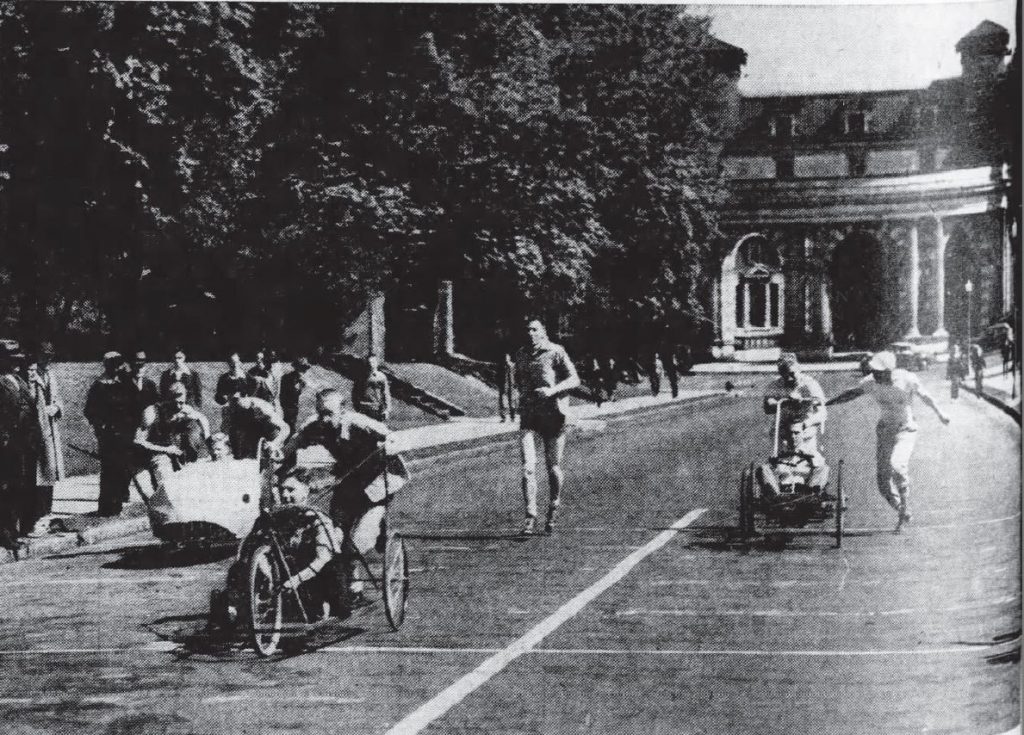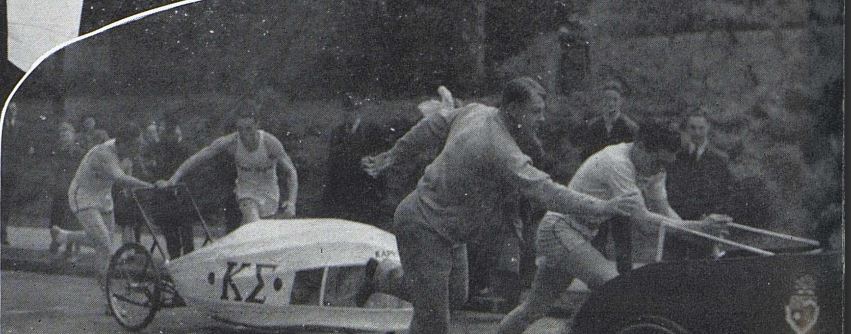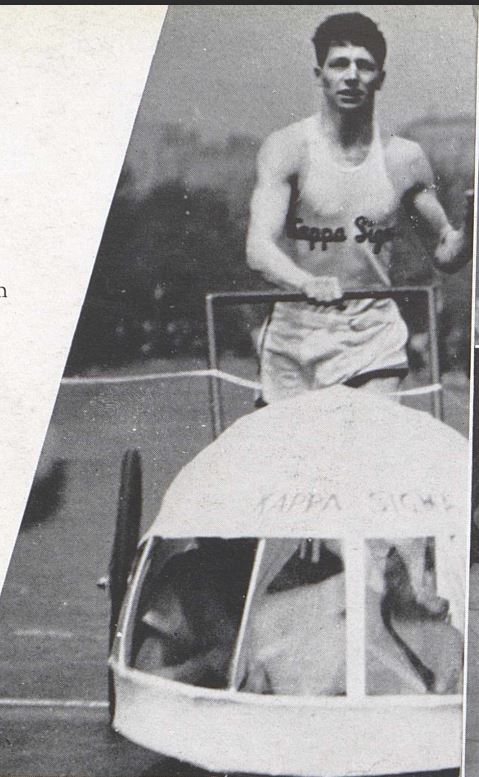Table of Contents: Intro & 1920; 1921-1923; 1924-1927; 1928-1932; 1933-1935; 1936-1939; 1940-1945; 1946-1949; 1950-1953; 1954-1956; 1957-1959; 1960-1963; 1964-1966; 1967-1969; 1970-1973; 1974-1976; 1977-1979; 1980-1983; 1984-1986; 1987-1989; 1990-1993; 1994-1996; 1997-1999; 2000-2003; 2004-2006; 2007-2009; 2010; 2011; 2012; 2013; 2014; 2015; 2016; 2017; 2018; 2019; Recap & 2020; 2021; 2022
Before we dive into the late 1930s, a quick explanation. Until now, we’ve been relying primarily on first-hand reporting (articles from the same year, or at worst the following year) to give a picture of the year in Buggy. For these primary sources, we’ve treated the articles as fact (unless, as noted in the Intro, there’s a reason to question it). Occasionally we have provided information from second-hand sources (such as articles from later years of the Tartan that look back from a historical perspective), as they add additional color, but they are also more unreliable, and thus we have called out the times we’ve provided information from those sources and our concerns (for example, in last week’s article, we noted that there is a conflict with respect to the material making up Beta’s 1932 buggy frame).
For the late 1930s, however, the Tartan digital archives are missing (1936-1939 are unavailable), and there are few non-Tartan sources for those years, so we are more heavily relying on those second-hand sources. So in this week’s article, we will tell you what limited information we know, which comes from first-hand sources, and then we will provide some additional color from the second-hand sources along with how accurate we believe that information to be. So without further ado, let’s dive into the 1930s, when it was a KapSig world and the rest of CMU was just living in it.
1936
Raceday: Prelims on Friday, May 8; Finals on Saturday, May 9
Sweepstakes Committee: Unknown
Race Results: (1) KapSig (2:46.8 – COURSE RECORD – Per 1971 Tartan)
Design Comp: (1) Beta
Weather: Sunny; High of 89/87, Low of 59/58
- Secrecy Abounds. It should be noted that by the 1930s, the sport of Buggy had already become the top secret domain that it has been for much of the last 90 years. Maybe that’s why we know so little about the late 1930s…
- KapSig Dynasty Begins. One of the greatest dynasties in Buggy history began in 1936. After winning in 1934 and then narrowly missing in 1935, KapSig broke through for good in 1936, picking up the first of what would become one of the longest winning streaks in Buggy history. And while it was the same core buggy used every year during that streak, they typically changed the covering and surface decorations every year (see the photos below for some of the looks that the KapSig buggy took on).
- Illegal Pusher Swap? This comes from our main second-hand source of the late 1930s, an article entitled “History of the Sweepstakes” from the 1966 Buggy Book. Some of the information in the article is inaccurate, so we don’t know if this is correct and we don’t know their source, but writer Chris Macosko noted that in 1936, Beta was DQ’d for an “illegal exchange of drivers.” If true, this suggests that either Beta’s driver swapped places with a pusher or another driver (unlikely in 1936), or that Beta’s actual driver was not the person that they listed on their roster (more likely).
- PiKA Finishes Fourth. We know KapSig won in 1936, but with spotty information we don’t know who else finished in the Top 3. We do know, however, that PiKA finished 4th, courtesy of the PiKA Beta Sigma Alumni Association history page. The main mechanics from the team appear to have been co-chairs John Duffy and Howard Tobler, and pledge (and eventual assistant chair) Charles Loughney. We also know that John Duffy also drove the PiKA buggy, while the push team consisted of Henry Lehne, Wayne Atwell, William Closs, and John Ewalt (presumably there was a 5th pusher, but we don’t know who that was).
- A PiKA Fire. Since we don’t have many Buggy stories to report, we’ll fill you in on a little Buggy-adjacent story. On December 26, 1935, while the brothers of PiKA were home for Christmas, the chapter house was destroyed by fire. It took four fire companies over 5 hours to put the fire out, due in part to below freezing temperatures and ice covered equipment, and several firemen were injured while fighting the blaze. In a bit of an ironic twist of fate, given the relationship of the fraternities later in the century, PiKA would end up moving into the former Sigma Nu house, which had been vacated when that fraternity briefly went inactive.
- Spring Carnival in 1936. We know very little about 1936, other than that KapSig won the race and Beta won Design Comp. So here’s a couple of other Spring Carnival facts from 1936:
- Back then, Spring Carnival included a Campus Queen, who was elected by the student body and then presided over all of the Carnival activities, including presenting trophies. In 1936, the Campus Queen was Mary Elizabeth Rowles.
- Another event that occurred during Spring Carnival was a women’s alternative to Buggy. The specific event varied over the years. 1936 had both a roller skate derby and a scooter race; it’s unclear if one or both of these were the women’s alternative to Buggy or if they were their own events.
- The Saturday of Carnival also saw a mushball game and a dance.
- 1936 Photos. Rather than throw all of the photos for this set of years at the bottom, we’re splitting them up because we’ve got so many! Here are a couple from 1936 (if you can ID any of the “unknown” buggies, please let us know!)
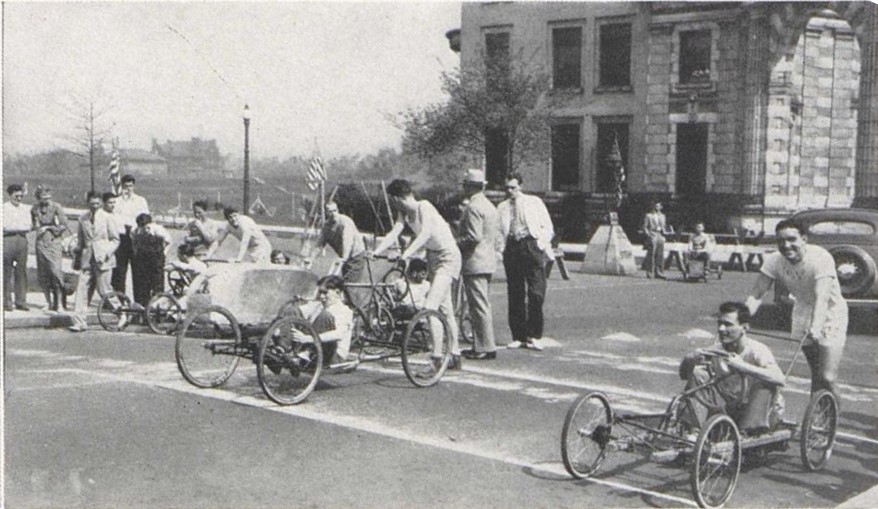
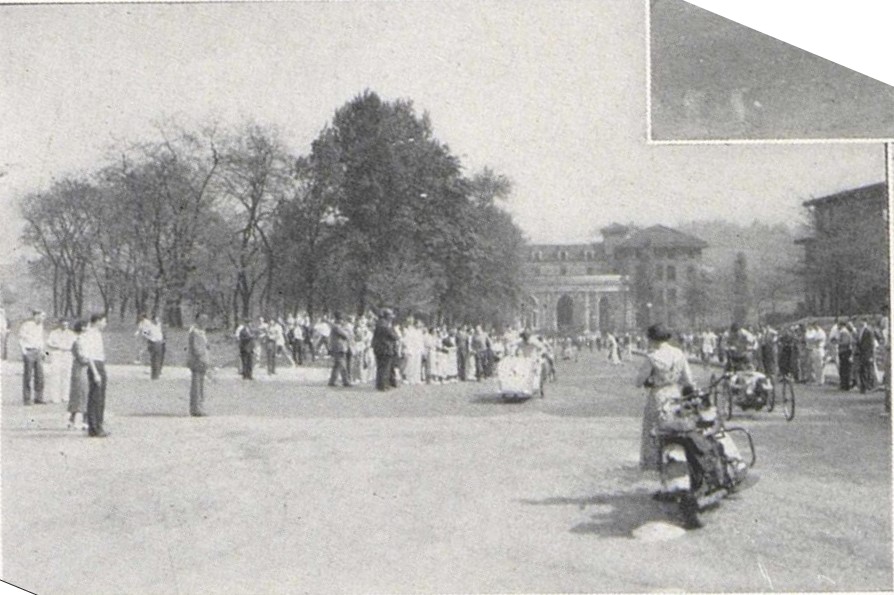
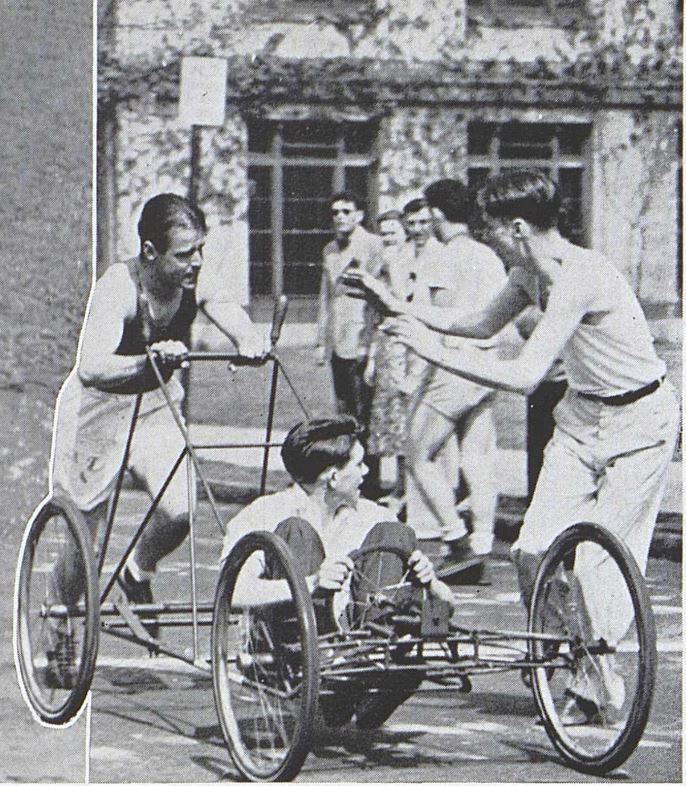
1937
Raceday: Prelims on Friday Morning, May 14; Finals on Saturday Morning, May 15
Sweepstakes Committee: Unknown
Race Results: (1) KapSig*
Design Comp: Unknown
Weather: Possible rain on Friday, maybe overcast on Saturday; High of 60, Low of 49/42
1937 is our current white whale. We know almost nothing about the year (we don’t even know for certain that KapSig won).
- White Whale. Here’s what we know about 1937, courtesy of the Pittsburgh Post-Gazette and Pittsburgh Press: (1) 10 Fraternities were entered to race, and (2) Prelims were on May 14 with Finals and Design Judging on May 15. That’s it.
- KapSig Won? In addition to the 2 things that we know, we reasonably confident that KapSig won the race, and I’m confident enough to list them as the winner above. But as noted throughout, we don’t have a first-hand source of this. Later editions of the Tartan note that KapSig has a long winning streak that covered the late 1930s. However, those articles sometimes conflict and are known to be inaccurate in some respects. For example, the April 23, 1940 issue of The Tartan noted that KapSig has won for “the past 5 years”; however, we know that this is incorrect, because Beta won in 1935, so KapSig could have won no more than 4 races in a row going into 1940. A 1946 article in The Tartan notes the winning streak from 1936-1941, which we believe is correct, but the Tartan’s track record when looking backwards at Buggy results isn’t great.
- Top 3 and Design? The 1966 Buggy Book, which printed the “complete” Sweepstakes results prior to the 1966 race, has KapSig as the winner in 1937 with a time of 3:00, followed by Beta in 2nd and ATO in 3rd. In addition, it has Beta winning Design Comp and ATO finishing 2nd. But right next to 1937 is a giant asterisk (similar to what we’ve listed above in “Race Results”), and the Buggy Book never goes on to explain what the asterisk is for (the only other year with an asterisk is 1929, and the Buggy Book’s listed 3rd place finisher from that year, Beta, conflicts with what we know from 1929 reports, which had SigNu in the Top 3). We don’t know where this information came from or if it’s accurate. So while we’re reasonably confident that KapSig won the race, we’re not willing to stake our reputation on the remainder of the results, or the time, from 1937, and thus we’ve only listed KapSig’s win above.
- ATO’s Buggy. From the “History of The Sweepstakes” article in the 1966 Buggy Book, ATO’s buggy in 1937 is quoted as being “a conglomeration of wood, galvanized iron pipe, leather upholstery and aluminum covering.” It’s possible that we’ve got a photo down below (though we can’t confirm that any of the ATO buggy photos were taken in 1937).
- Do you have grandparents who were at CMU in 1937? If so, ask them if they remember anything about Buggy. In fact, it doesn’t just have to be about 1937; it can be any year! Let us know.
- 1937 Photos:
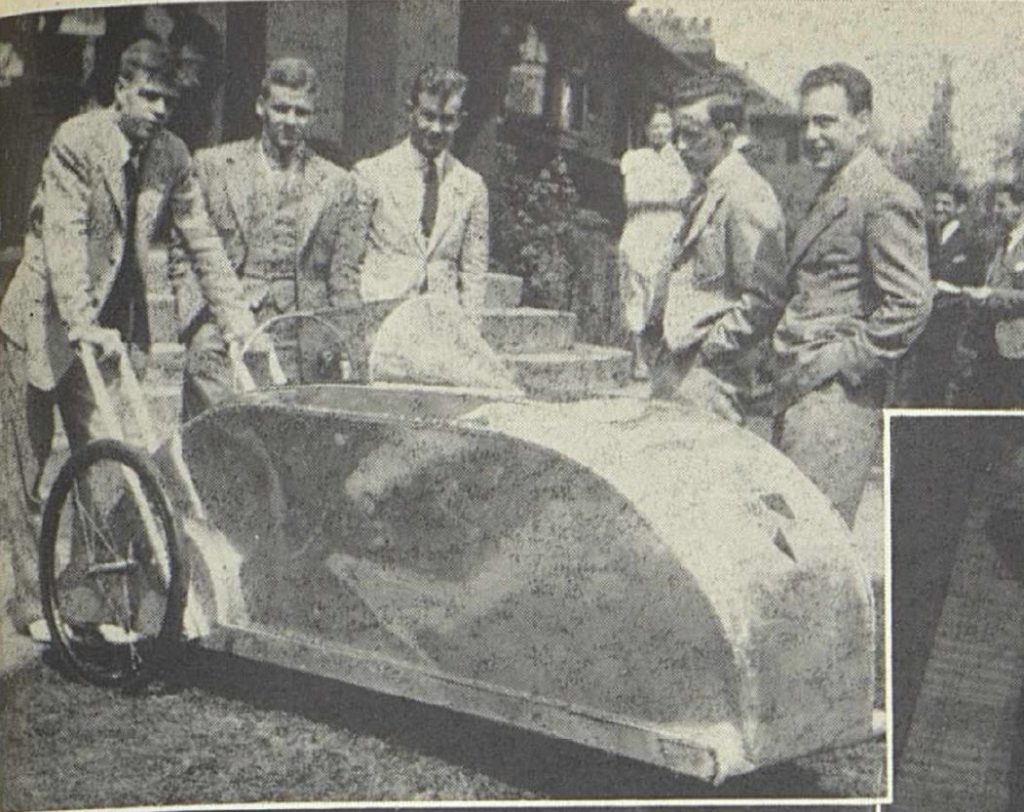
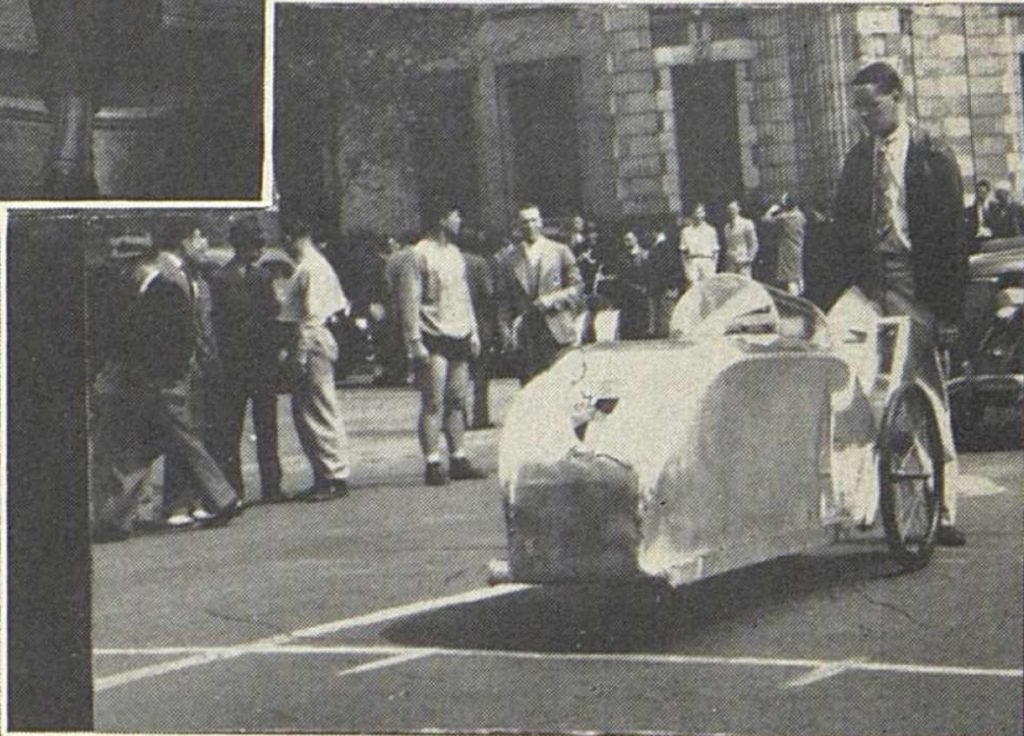

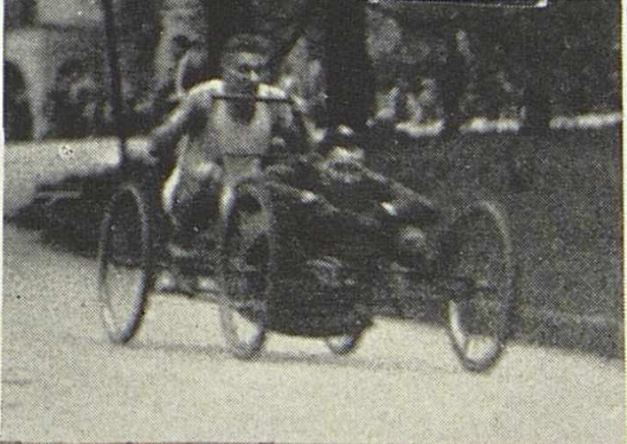


1938
Raceday: Prelims on Friday, May 13; Finals on Saturday, May 21* (See below)
Sweepstakes Committee: Unknown
Race Results: (1) KapSig (2:43.0 – COURSE RECORD – Per 1971 Tartan)
Design Comp: (1) PiKA
Weather: Sunny and cold on Friday, Overcast on Saturday; High of 54/72, Low of 35/54
- KapSig Makes It 3. We know little about the actual race. But what we do know, courtesy of the 5/13/1938 Pittsburgh Sun-Telegraph, is that 4 fraternities advanced to the Finals. They were KapSig, DTD, Beta, and ATO. We know that KapSig won the race in a record 2:43.0 time, and based on the 1966 Buggy Book, we believe that DTD and Beta were 2nd and 3rd, respectively.
- Rain Delay? We don’t have a primary source for the Finals in 1938. But the info about 1938 from the “History of The Sweepstakes” article in the 1966 Buggy Book does comport with what we do know about the year, and so we’re classifying this information as “fairly likely”. Finals were originally scheduled for Saturday, May 14. But it poured in Pittsburgh on that day, with nearly 1 inch of rain falling (courtesy of our weather data). Per the 1966 Buggy Book, this resulted in the Finals being postponed 1 week, which we have interpreted to mean that Finals were actually run on Saturday, May 21.
- PiKA Births a Ladybug. We assume that PiKA built a new Buggy in 1938, because they pulled off a bit of a surprise in winning the Design Competition. What made their design unique? An edition of the Tartan in 1963 noted that back in the 1930s, PiKA had a buggy that looked like an elongated lady bug with handles. How elongated? The 1966 Buggy Book’s “History of the Sweepstakes” article says the Buggy was 12 feet long, with a canopy of aluminum tubes covered with airplane silk! Is that correct? Judge for yourself, as a couple of photos of this Buggy are below (the “ladybug” covering appears to have debuted in 1939). Furthermore, courtesy of the June 1938 Shield & Diamond (the PiKA national magazine), we know that the buggy’s chassis was made of “welded steel tubing over which a furring of fine aluminum tubing was placed”, and that the “doped airplane fabric” was painted bright yellow, with a red PiKA crest featured on each side. We also know that the “windshield” was actually made of pyralin, a type of plastic that is more commonly known today as celluloid, and that the driver laid prone on a leather mat inside the buggy. The buggy weighed 110 pounds, and was built by PiKA brothers Stan Stannic, Will Gee, Bob Owen, and George Gandy.
- ATO’s Troubles. According to the 1966 “History of the Sweepstakes” article, ATO was one of the 4 finalists in 1938, but they had a rough year. The article says that ATO put up a 3:00 time in the Prelims, earning them a spot in the Finals. But they were forced to withdraw after the rain delay because their top pusher, Mel Cratsley (who played on the football team, basketball team, and the track team before going on to become CMU’s Basketball Coach and Athletic Director from 1949-1966), was unavailable due to a track meet.
- Beta’s Wheels. According to the “History of the Sweepstakes” article, Beta had troubles in 1938 as well. They almost missed the Finals when mechanic Dean Vance forgot to bring their wheels to the course. Luckily they retrieved the wheels in time and placed 3rd, according to the article.
- 1938 Photos: Some questions: Is the Starting Line photo actually from 1938? Is that really ATO’s buggy (the emblem sure looks right). Was PiKA’s buggy really 12-feet long?
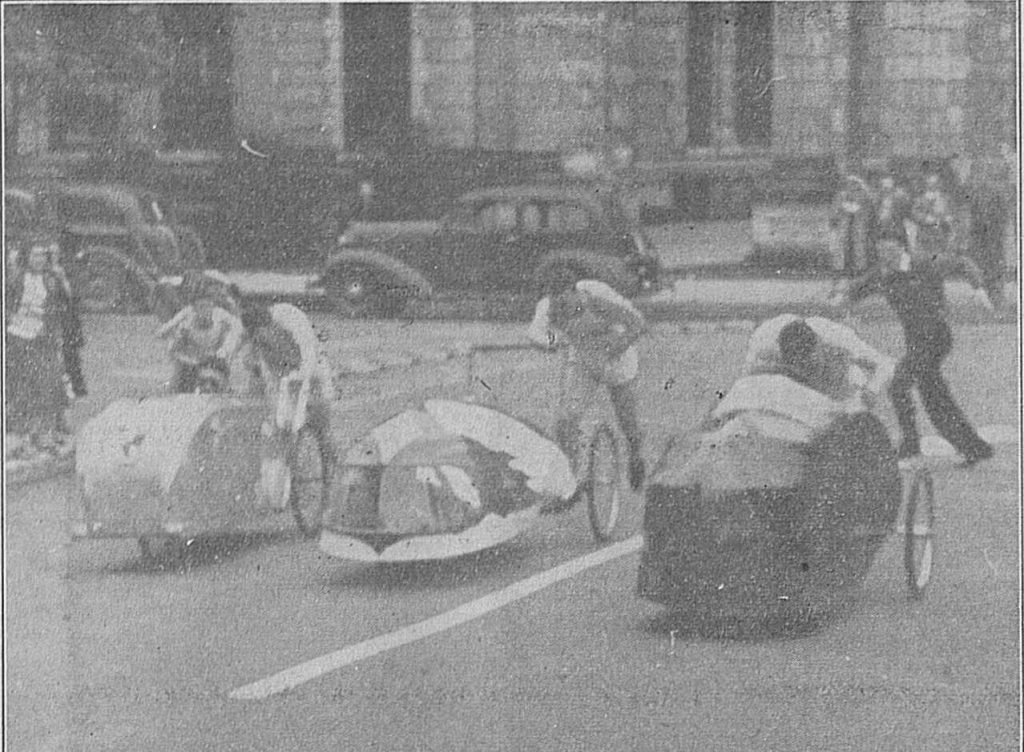

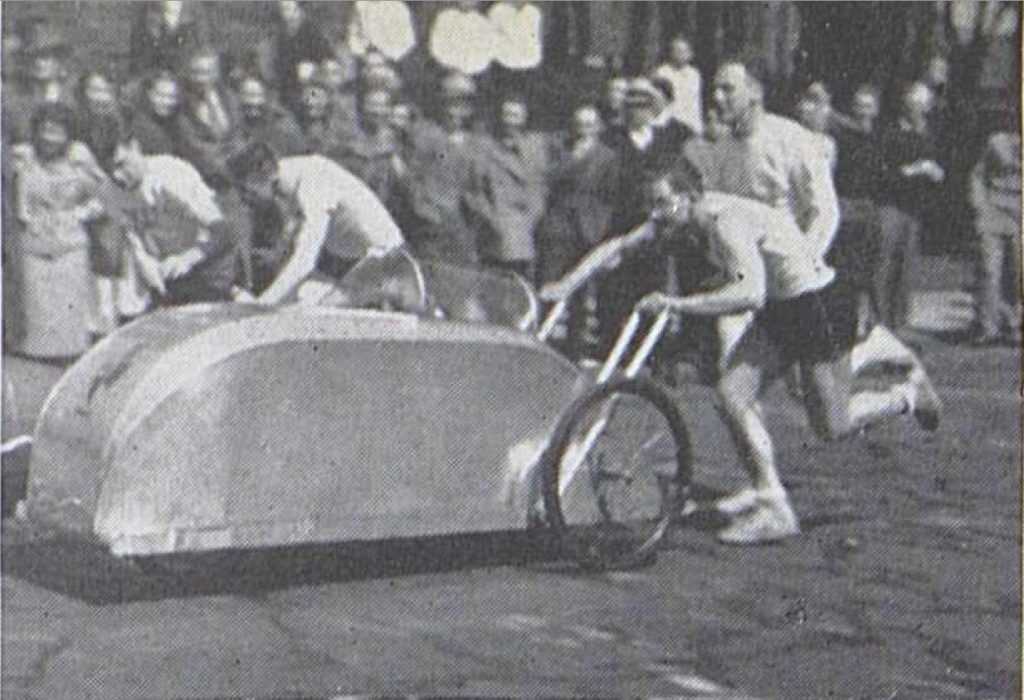
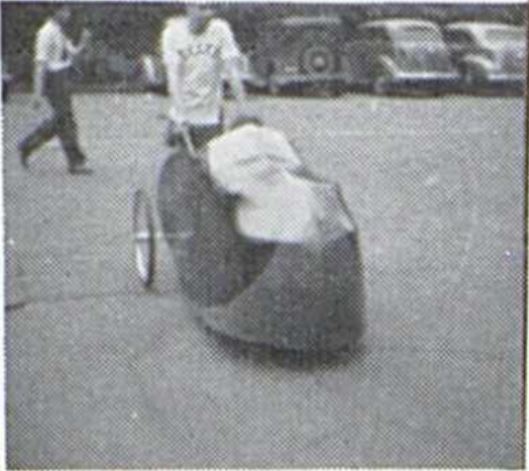
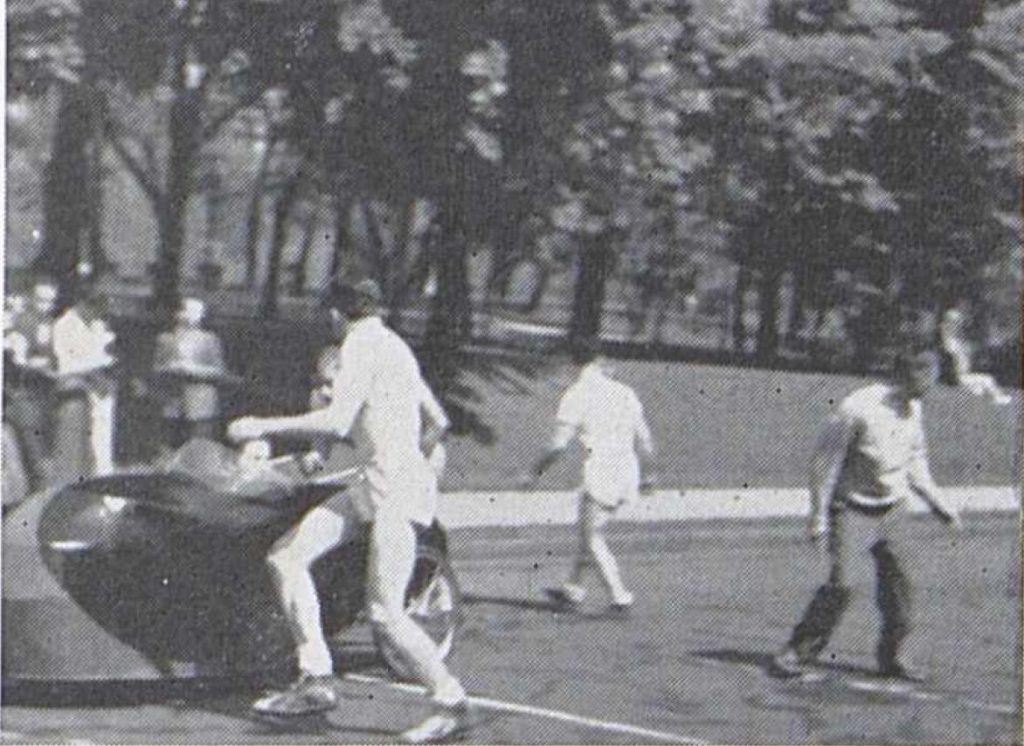
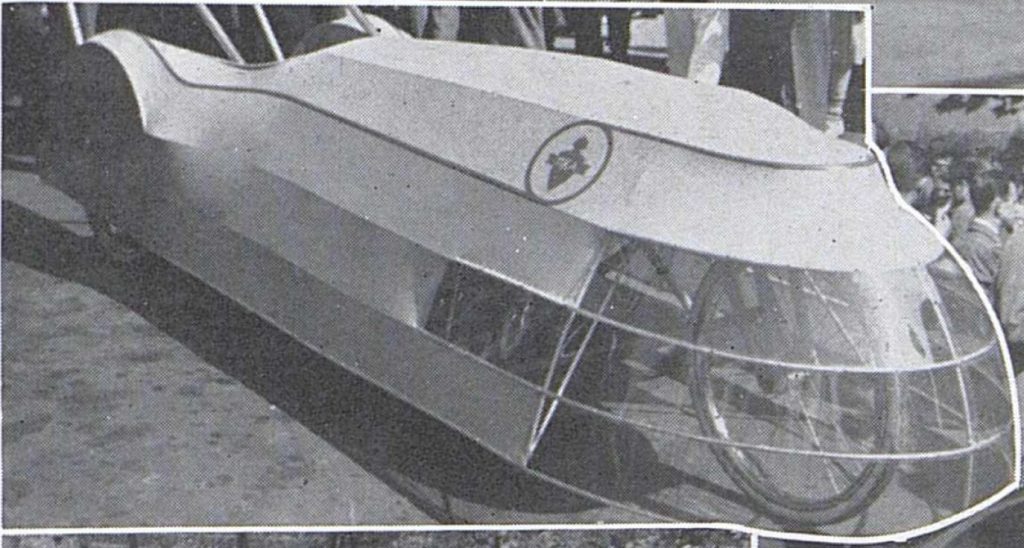
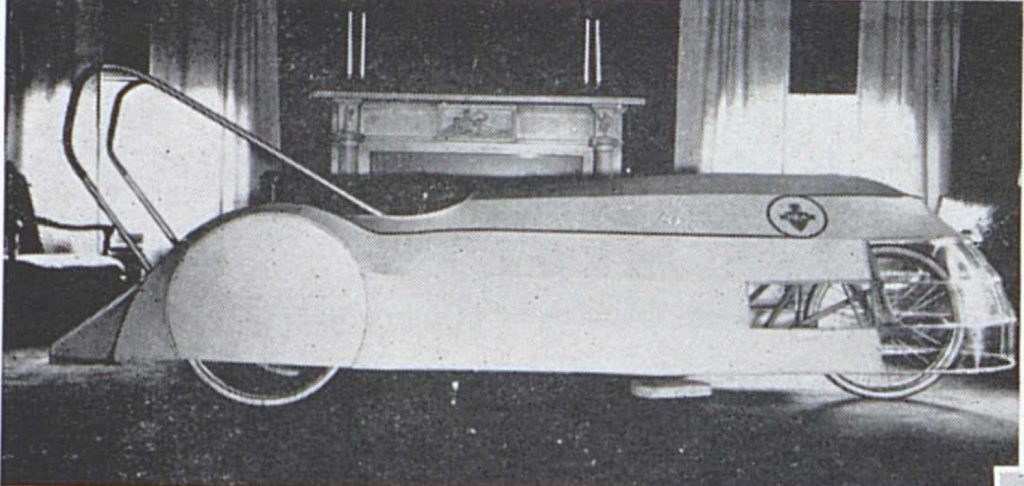
1939
Raceday: Prelims on Friday, May 12; Finals on Saturday, May 13
Sweepstakes Committee: Unknown
Race Results: (1) KapSig; (2) DTD
Design Comp: (1) PiKA
Weather: Sunny on Friday, Overcast on Saturday; High of 60/60, Low of 35/44
- 1939 – What We Know. We don’t know how many buggies or heats there were in 1939, but we know there were at least 2
(my guess is that there wereonlytwo, as these late 1930s years seemed to have relatively small fields)(see below for an update). The first heat was won by KapSig in a time of 2:46.6. The second heat saw Beta, Theta Xi, and ATO square off, and the heat was won by ATO in a time of 3:06. That second heat was disastrous for Beta, as their buggy flipped over and crashed, leaving the door wide open for ATO to make the finals. In the finals, we know that KapSig won in a landslide, finishing more than 50 yards in front. We also know that PiKA took home the Design Comp trophy again…and that’s it.
- 1939 – What We Think is Likely. From the “History of the Sweepstakes” article in the 1966 Buggy Book, we think that KapSig’s winning time was a 2:44, just 1 second off their 1938 course record. We also think that DTD finished 2nd (the Buggy Book has “ATO ?” in 3rd, which we believe based on the fact that they won Heat 2 in the Prelims).
- 1939 – What We’re Guessing. We’ve got some conflicting information about Beta’s buggy from 1939, but my best guess is that the old buggy, shaped like a bullet, was retired after 1938 and a new buggy was introduced to the course in 1939. Beta’s crash in the Prelims damaged the buggy’s covering but reportedly the structure survived; a 1940 article suggested that Beta would be putting on a new cover to race in 1940 (though they ultimately built a new buggy).
- Photo Research Leads to New Beliefs. I’m adding this bullet after the initial post, because we had an issue with the date of a particular photo that has led to some new beliefs about 1939. We now believe that there were 3 Prelim heats in 1939, not 2. We believe that the first, won by KapSig, can be seen in this photo. We don’t know who the other 3 buggies belong to, but my guess is that the 3-wheeler in Lane 2 is DU and the 4-wheeler in Lane 3 is SAE. It’s impossible to see the 4th buggy, so we are not sure, but there’s a chance that it’s SigNu. Heat 2 was Beta, Theta Xi, and ATO as noted above, and because of this photo and the separate Finals photos that we have, we now believe that there was a 3rd heat, consisting of PiKA, DTD, and a 3rd unknown team. We have updated captions below as well.
- 1939 Photos. Below includes a number of photos that we have questions about. Are the organizations that the Pittsburgh Post-Gazette identified in their caption correct (the buggies don’t exactly look like these orgs’ buggies from past or future years)? If you’ve got thoughts, let us know in the comments (we’ll update this as necessary if any questions get answered)
